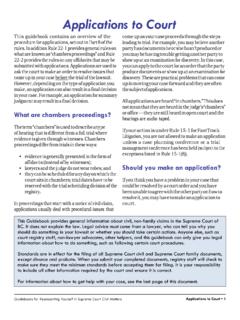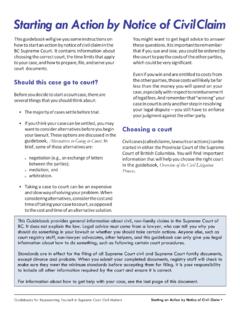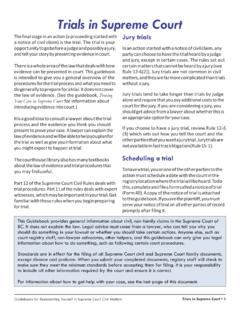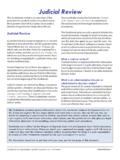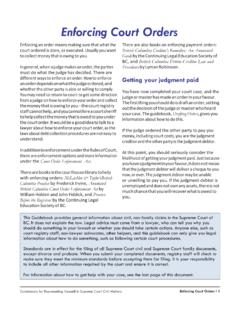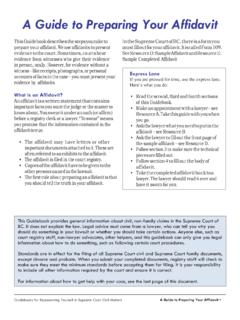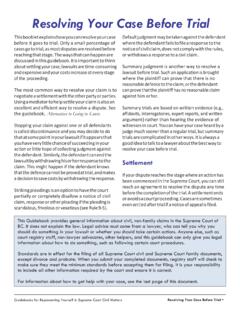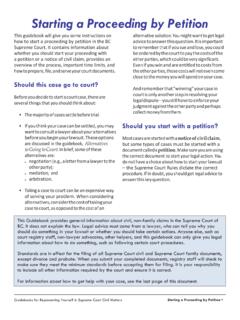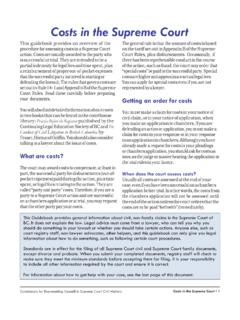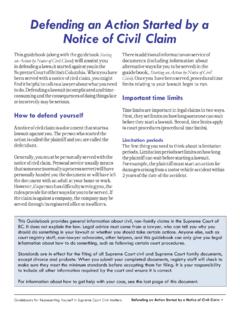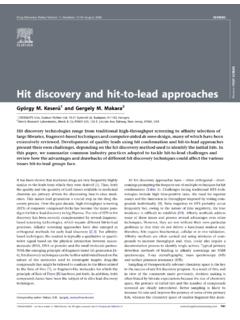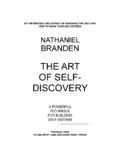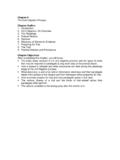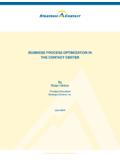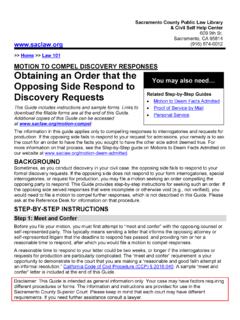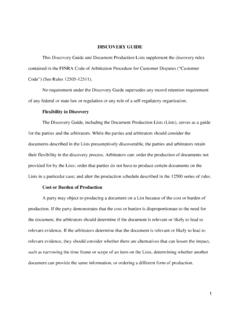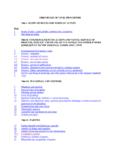Transcription of The Discovery Process - supremecourtbc.ca
1 The Discovery Process The Discovery Process is the way you (and the other party) discover the other side s view of what happened in the case. This Process is like a roadmap allowing you to see the other side s version of when and where things happened. Discovery is a very important Process because it allows you to collect the information necessary to assess the strengths and weaknesses of both your case and the case of the opposing party. It also shows you where you and the other party agree and disagree. This guidebook provides only a general overview of the rules that apply if you are involved in a case that was commenced by a notice of civil claim (called an action ).
2 Note that the Discovery Process is not available in claims started by a petition. Also, note that different Discovery rules apply if you are proceeding by fast track litigation (see the guidebook, Fast Track Litigation). Steps in the Discovery Process There are several possible steps in the Discovery Process , although it may not be necessary for you to take all of these steps in your case. Each of these steps is described more fully below. Discovery of documents: You must disclose to the other parties in the proceeding all of the documents that could be used by any party at trial to prove or disprove a material fact. This means that you must describe the documents that you have to the other party, and make them available for the other party to examine.
3 Examination for Discovery : This is a meeting where one party asks an opposing party a series of questions. Interrogatories: This is a series of written questions provided to the other party to be answered in writing. They may only be used with leave (permission) of the court. Pre-trial examination of witnesses: This Process may be used if there is a person who has material evidence relating to the case and who is not a party to the action. It may only be used with leave (permission) of the court. Notices to admit: Notices to admit allow you to ask the other party to admit the truth of certain facts. You may want to consult a lawyer before beginning the Discovery Process .
4 A lawyer can give you important information and advice about how to find out what you need to know about the other party s case, as well as how much information you must disclose to the other parties in your proceeding. Guidebooks for Representing Yourself in Supreme Court Civil Matters The Discovery Process 1 This Guidebook provides general information about civil, non-family claims in the Supreme Court of BC. It does not explain the law. Legal advice must come from a lawyer, who can tell you why you should do something in your lawsuit or whether you should take certain actions. Anyone else, such as court registry staff, non-lawyer advocates, other helpers, and this guidebook can only give you legal information about how to do something, such as following certain court procedures.
5 Standards are in effect for the filing of all Supreme Court civil and Supreme Court family documents, except divorce and probate. When you submit your completed documents, registry staff will check to make sure they meet the minimum standards before accepting them for filing. It is your responsibility to include all other information required by the court and ensure it is correct. For information about how to get help with your case, see the last page of this document. The Discovery Process is different for fast track litigation under Rule 15-1. If your action is subject to Rule 15-1 you should read the rule carefully and refer to the guidebook, Fast Track Litigation.
6 Discovery of Documents Rule 7-1 sets out the requirements for Discovery and inspection of documents. It allows you to get access to the documents of the other party that are relevant to your case and requires you to allow the other parties to see your relevant documents. What is a document? Rule 1-1 sets out the definition of document. The definition is quite broad, and includes photographs, films, sound recordings, any record of a permanent or semi-permanent character, or any information recorded or stored by any means of any device. So when you re looking for documents, make sure you think of disks, tapes, and computer files, as well as photographs and films.
7 Which documents must be disclosed? To begin the Discovery of documents Process , you must prepare a list of documents in Form 22 that: lists all documents (with a brief description of each) that are or have been in your possession or control that could, if available, be used at trial to prove or disprove a material fact; and all other documents which you intend to refer to at trial. A material fact is something that is directly relevant to your case. For example, if the dispute is about a broken contract for the sale of a boat, the sale price is a fact that is relevant to the case. The sale price is therefore a material fact.
8 Because the contract could be used to prove the sale price (and probably many other material facts) the contract must be disclosed in your list of documents. For example, let s say you find a photo of the boat before the sale took place. The condition of the boat prior to the sale is probably relevant to the case. As the photo could be used to prove or disprove a material fact (the condition of the boat) it must be disclosed. By contrast, a contract with the same person for the sale of a different boat three years earlier could probably not be used to prove or disprove any facts material to the present dispute and therefore would not have to be listed.
9 Preparing a list of documents Once you have decided which documents need to be disclosed, you must list the documents on Form 22. The list must then be served on all other parties within 35 days after the end of the pleading period ( , when the notice of claim, response, counterclaim, reply, and any amendments are completed). The Form 22 list of documents has three parts: Part 1: Includes all documents that are or have been in your possession or control and that could be used by any party at trial to prove or disprove a material fact. For example: 15 September 2008, contract of employment between XYZ Company and John Brown.
10 (Then check the box if the document is no longer in your possession or control.) Part 2: Includes all other documents (if any) that you intend to refer to at trial. For example, these may be documents that you know exist but that were never in your possession or control. Part 3: Some of your documents may be privileged and that means that the other party is not entitled to see them. For example, communications between a lawyer and his or her client are privileged. If you consulted with a lawyer about your case and received a letter from the lawyer that gave you some advice about the case, the letter would be a privileged document and you would not be required to give a copy of it to the other party.
